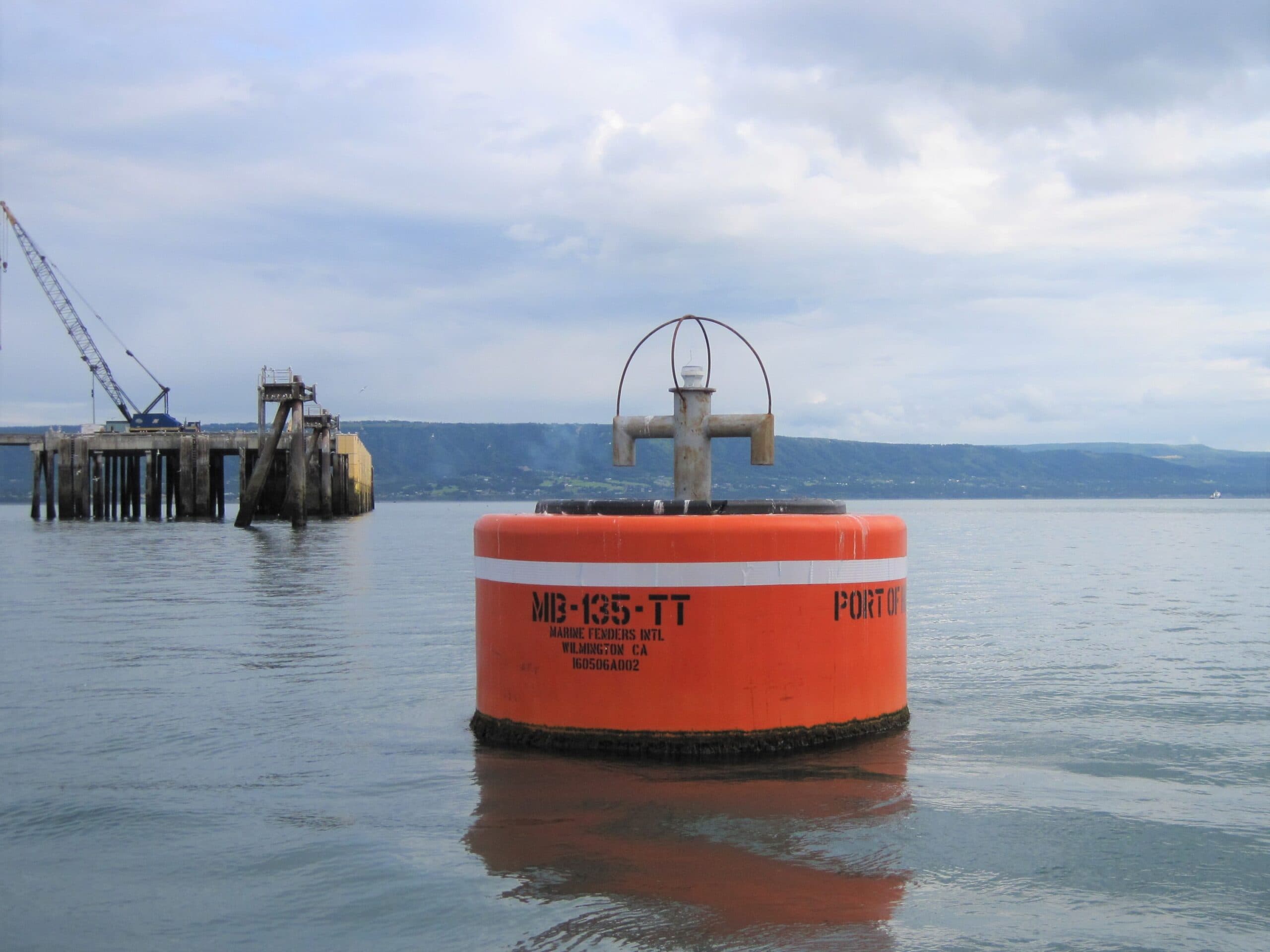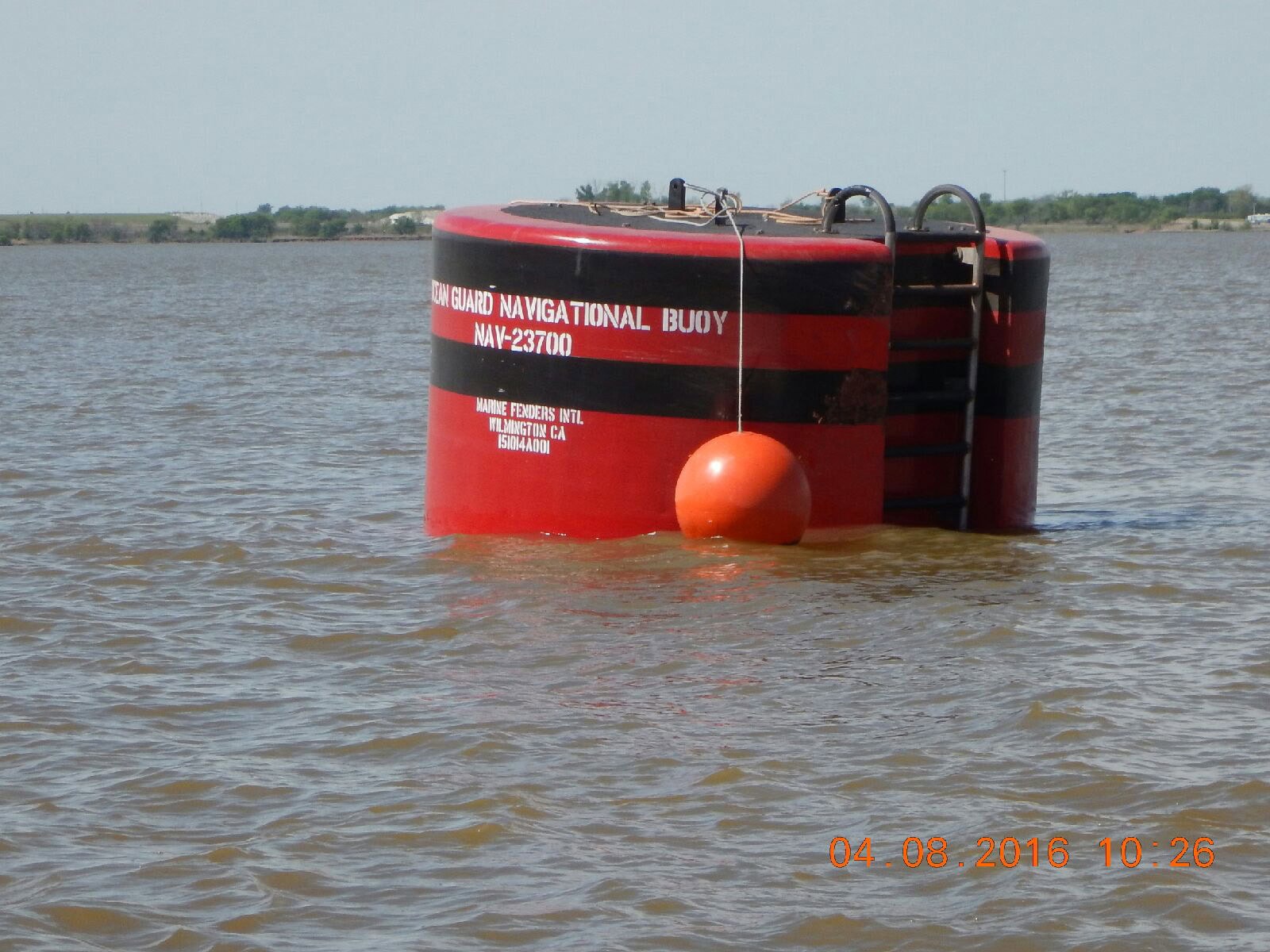Mooring buoys are maritime tools that help anchor ships, boats and vessels securely in lakes, rivers, open ocean and coastal areas. They include a buoyant structure, usually brightly colored and easily visible on the water’s surface. Connected to the buoy is a durable chain or line that extends to an anchor or weight placed on the seabed.At Marine Fenders International, we consistently engineer and deliver top-tier marine products to ports and military installations worldwide! One of the company’s standout features is our proactive engagement with customers. We do not just offer standardized solutions but are a trusted partner in addressing the most complex mooring and fendering requirements. Authentic buoys by Marine Fenders International possess the Ocean Guard brand name.
Operating Principles of a Mooring Buoy Below are the working principles of a mooring buoy that revolve around providing a stable anchoring point for ships and vessels in the water:

Buoyancy
The buoys are specifically engineered to possess the inherent ability to float on the water's surface. This buoyancy is achieved through specialized materials like closed-cell foams integrated into the design. These elements can effectively support their weight and the substantial loads exerted by the attached chain or line.
a
Attachment to Seabed
The buoy’s operation hinges on its secure connection to an anchor on the seabed. This weight can assume various forms, including a concrete block or a heavy metal structure. It serves as the counterforce required to maintain the floater’s position on the water's surface. A robust chain or line also extends from the buoy and securely fastens to the anchor, forming a reliable and stable mooring system.
a
Visibility
Mooring buoys are often painted in vibrant, high-visibility colors to ensure maritime traffic safety through easy identification. They also feature reflective materials strategically placed on their surfaces. This attention to visibility is crucial in low-light conditions or busy waterways, as it aids boaters in swiftly recognizing the buoy.
a
User Attachment
A mooring buoy typically has user-friendly hardware, often a sturdy tee-top (bollard), pad eye, swivel eye, bail eye, hawse pipe for through chain or wire rope. Ships, barges, and ships use these attachment points to secure their vessels. They can keep a stable and designated position by connecting lines from their ships to the buoy's hardware. This helps prevent drifting and ensures secure and reliable mooring.
a
Mooring Area Designation
Mooring buoys are important in identifying specific regions for vessel docking and anchoring. Maritime authorities and operators can effectively organize and regulate traffic by strategically placing these buoys. This approach reduces congestion while significantly lowering the possible harm to the seabed caused by traditional anchor deployment.
a
Flexibility
These mooring buoys are designed in various sizes and configurations, allowing them to cater to the diverse needs of ships. These buoys are designed and engineered to match the type and size vessel to be moored, the water depth and currents. This adaptability ensures efficient and secure mooring, reducing the risk of damage to vessels or buoys.
aEnvironmental Benefits of a Mooring Buoy
Mooring buoys represent an advancement in maritime technology with a profound positive environmental impact. One consideration for these buoys is their influence as environmentally responsible alternatives to traditional anchor systems. Traditional anchors — which drop heavy metal objects onto the seabed — can substantially harm fragile underwater ecosystems and disrupt marine habitats. This can lead to severe damage to aquatic flora and fauna.
In contrast, mooring materials are designed to keep boats from coming into direct contact with the seabed. Thus, they effectively mitigate the damage caused by conventional anchors and reduce the likelihood of disturbing the aquatic ecosystems. This ecologically sound approach aligns with the growing emphasis on conservation efforts and sustainable maritime practices.
The adoption of buoys also supports broader sustainability goals in the industry. As conservation efforts intensify and regulations become apparent, mooring floaters emerge as a responsible and environmentally conscious choice. They minimize the negative impacts on the seabed and set a standard for eco-friendly practices in the maritime sector.
The Role of Color Coding in Maritime Navigation and Safety
Color coding in mooring buoys is a visual language that mariners can rely on to understand the purpose and function of each marker. Here are some of the most significant roles that standardized color codes play in creating a universally understood and efficient navigation system:
Identification and Purpose
Each buoy is assigned a specific color scheme corresponding to its purpose and location. For instance, a green or red mooring device marks a navigable channel's left and right sides, respectively. Yellow buoys might indicate special areas like anchorages, while white or orange buoys can be used for general navigation. The Ocean Guard buoy markings identify the type of buoy, its purpose and its buoyancy capacity.
Safe Passage
The color coding is an integral component of the lateral buoyage system. This helps mariners determine the correct side to pass a buoy when entering or leaving a waterway. Standards governed by the International Association of Marine Aids to Navigation and Lighthouse Authorities (IALA) also ensure that vessels avoid collisions and accidents.
dConsistency and Global Standards
Standardized color codes guarantee uniformity and consistency in maritime navigation worldwide. Regardless of their origin, mariners can rely on these internationally recognized color schemes to safely navigate waters. This standardization simplifies information communication, reducing the risk of confusion or misinterpretation.
aQuick Recognition in Emergency Situations
Color-coded buoys enable rapid recognition, which is crucial during emergencies. When time is of the essence, mariners and boaters can immediately identify the type and purpose of a buoy. This aids in their navigation choices and responses, especially in low-visibility scenarios, equipment malfunctions, or medical emergencies.
aThe Role of Color Coding in Maritime Navigation and Safety
Color coding in mooring buoys is a visual language that mariners can rely on to understand the purpose and function of each marker. Here are some of the most significant roles that standardized color codes play in creating a universally understood and efficient navigation system:
-
Identification and Purpose
Each buoy is assigned a specific color scheme corresponding to its purpose and location. For instance, a green or red mooring device marks a navigable channel's left and right sides, respectively. Yellow buoys might indicate special areas like anchorages, while white or orange buoys can be used for general navigation. The Ocean Guard buoy markings identify the type of buoy, its purpose and its buoyancy capacity.
-
Safe Passage
The color coding is an integral component of the lateral buoyage system. This helps mariners determine the correct side to pass a buoy when entering or leaving a waterway. Standards governed by the International Association of Marine Aids to Navigation and Lighthouse Authorities (IALA) also ensure that vessels avoid collisions and accidents.
-
Consistency and Global Standards
Standardized color codes guarantee uniformity and consistency in maritime navigation worldwide. Regardless of their origin, mariners can rely on these internationally recognized color schemes to safely navigate waters. This standardization simplifies information communication, reducing the risk of confusion or misinterpretation.
-
Quick Recognition in
Emergency SituationsColor-coded buoys enable rapid recognition, which is crucial during emergencies. When time is of the essence, mariners and boaters can immediately identify the type and purpose of a buoy. This aids in their navigation choices and responses, especially in low-visibility scenarios, equipment malfunctions, or medical emergencies.
Technological Advancements in the Maritime Industry
Advancements in buoys have significantly enhanced their role and effectiveness in the maritime industry. Here are some notable innovations and their impact:
Advanced Materials
These buoys are constructed with a central steel strength member, inner closed cell rigid urethane buoyancy foam, followed by an impact absorbing resilient thermal laminated cross-linked polyethylene core foam, and finally encapsulated with a tough filament nylon reinforced urethane skin. They are extremely durable and resistant to damage from the elements, including saltwater and UV radiation. This enhanced durability translates to longer-lasting floating devices, reducing the need for frequent replacements.
Automatic Identification System (AIS) Integration
AIS-equipped mooring and navigational buoys can broadcast their positions and relevant information to nearby vessels. This technology is crucial for collision avoidance and improved safety. Mariners can also receive real-time data about the device’s location and purpose, lowering the risk of accidents in busy waterways.
LED Lighting
LED lights have largely replaced incandescent bulbs on mooring and navigational buoys. LEDs are more energy-efficient, consume less power, and have a longer lifespan. They are also highly visible over greater distances, vital for nighttime and low-visibility conditions. Furthermore, mariners and sailors can better identify markers, contributing to safer journeys.
Remote Monitoring Systems
Remote monitoring technology allows for continuous surveillance of buoy conditions. Sensors can detect issues such as battery levels, equipment malfunctions, or shifts in position due to rough seas or storms. This system enables a rapid response to problems, reducing downtime and ensuring that buoys remain effective navigation aids.
Smart Buoys
Smart buoys feature different sensors for water quality, weather conditions, and wave data. These elements provide real-time data, which can be transmitted to maritime authorities and vessels. For example, knowledge of changing weather patterns or sea conditions can help ships alter their routes to avoid dangerous areas. This enhances safety and navigation efficiency.
Solar-Powered Buoys
Integrating solar panels into buoy designs represents a significant step toward sustainability in the marine industry. Solar power minimizes the device’s environmental impact and lowers operational costs by reducing battery replacements or grid-based power sources. These specialized floaters can operate for extended periods, even in remote locations.
Upgrade Your Maritime Equipment With Marine Fenders International!
At Marine Fenders International, we offer diverse floating devices designed to meet the most stringent maritime requirements! From mooring equipment to oceanographic buoys for research, our products are engineered with unsinkable construction and exceptional impact absorption capabilities. We also provide cutting-edge port security barrier systems, camels, and marine fenders. Contact us or request a quote to get started!
Contact



